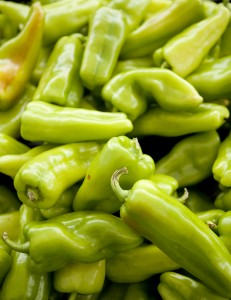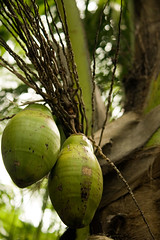Inside The New York Botanical Garden
Posted in Mario Batali's Edible Garden, Programs and Events on September 14 2012, by Matt Newman
 With autumn so near at hand, you’d think the excitement would be winding down in the Ruth Rea Howell Family Garden. Most vegetable gardens in New York are offering up the last of their produce right about now, while green thumbs stow their trowels for the next spring planting. But at the NYBG, the best of the season is still ahead of us! In fact, the atmosphere is nearly humming with anticipation for the peak event of the summer: Mario Batali’s Edible Garden Festival. And while the legendary chef’s top culinary minds have inspired plenty of palates during Family Dinners throughout the season, it’s Mario himself that will treat your tastebuds for September’s pièce de résistance.
With autumn so near at hand, you’d think the excitement would be winding down in the Ruth Rea Howell Family Garden. Most vegetable gardens in New York are offering up the last of their produce right about now, while green thumbs stow their trowels for the next spring planting. But at the NYBG, the best of the season is still ahead of us! In fact, the atmosphere is nearly humming with anticipation for the peak event of the summer: Mario Batali’s Edible Garden Festival. And while the legendary chef’s top culinary minds have inspired plenty of palates during Family Dinners throughout the season, it’s Mario himself that will treat your tastebuds for September’s pièce de résistance.
Now that the Family Dinners have come and gone, I got to wondering what might end up on Mario’s menu. And when you think of Italian cooking, you don’t have to be shy about it: your mind leaps straight to the tomatoes. Plump and delicious, blushing red (or yellow, or purple), they take center stage in so many of the dishes we’ve come to love. Still, while picking my way through the Family Garden in recent weeks, I thought to myself, “Why let the tomatoes hog the spotlight?” They’re delectable–don’t get me wrong–but Italy’s culinary history encompasses so much more! Mario knows this better than anyone. And when his acclaimed chefs first planted their vegetable plots, they dotted the Family Garden with leafy greens, pungent onions, and herbs enough to make your spice rack green with envy. And the peppers! So many peppers, in myriad shapes and colors.
Read More
Posted in Exhibitions, The Edible Garden on July 17 2009, by Plant Talk
 Gregory Long is President and CEO of The New York Botanical Garden.
Gregory Long is President and CEO of The New York Botanical Garden.
 The Edible Garden is meant to inspire visitors and to teach them about growing great food. One of the 11 exhibits featured in the summer-long celebration, Tropical Fruits, Roots, and Shoots in the Enid A. Haupt Conservatory, not only delivers on both counts but is a real showstopper as well, with more than 280 tropical plants and fruit-bearing trees, and dozens in flower or fruit right now.
The Edible Garden is meant to inspire visitors and to teach them about growing great food. One of the 11 exhibits featured in the summer-long celebration, Tropical Fruits, Roots, and Shoots in the Enid A. Haupt Conservatory, not only delivers on both counts but is a real showstopper as well, with more than 280 tropical plants and fruit-bearing trees, and dozens in flower or fruit right now.
Francisca Coelho, Senior Curator and Associate Vice President for Glasshouses and Exhibitions, has outdone herself with this tropical edibles exhibit, which features lush, elaborate displays of rare and beautiful vegetation, including everyday favorites like coffee, coconut, and cinnamon growing alongside more unusual fare like passion fruit, tamarind, and açai.
 Fran presents a global as well as a personal view of foods. You can see and learn about some of the world’s basic food crops such as rice, corn, and sorghum—staples many people have never seen in their plant form—as well as witness 42 kinds of hot peppers, Capsicum (and a handful of sweet varieties). Fran grew up eating food accented with peppers in her native Trinidad. In the Caribbean, peppers are showy and spicy, and the same plant can produce fruits of widely divergent colors. For instance, the Bolivian rainbow pepper starts off purple and then turns yellow and then orange and then red. “Green and red peppers are pretty boring. Gardeners should go for a variety on both color and taste,” Fran says. Some of her favorite recipes utilizing peppers are posted on our Edible Garden Web pages.
Fran presents a global as well as a personal view of foods. You can see and learn about some of the world’s basic food crops such as rice, corn, and sorghum—staples many people have never seen in their plant form—as well as witness 42 kinds of hot peppers, Capsicum (and a handful of sweet varieties). Fran grew up eating food accented with peppers in her native Trinidad. In the Caribbean, peppers are showy and spicy, and the same plant can produce fruits of widely divergent colors. For instance, the Bolivian rainbow pepper starts off purple and then turns yellow and then orange and then red. “Green and red peppers are pretty boring. Gardeners should go for a variety on both color and taste,” Fran says. Some of her favorite recipes utilizing peppers are posted on our Edible Garden Web pages.
 While the exhibit features plants that have edible parts, many more plants beyond peppers are ornamental. Gardeners have manipulated edible plants over the centuries to hybridize ornamentals. Fran notes: “When we garden in the Caribbean, we stick ornamentals among the food plants.” Purple seems to be an attention-getting, commanding, vibrant color with the most captivating foliage. Cordyline fruticosa ‘Negri’, the ti (pronounced “tie”) plant has deep purple, almost black, leaves. It is often used as a border plant in the Caribbean and is also used in cooking: food is wrapped in the large, thin leaves and dropped into a broth, stew, or soup. Other ornamental food plants include the grain amaranth (Amaranthus), which was used by Aztecs as cereal, and shiso (Perilla), with its deep purple, fluted, undulating leaves, used as a seasoning and as a tea.
While the exhibit features plants that have edible parts, many more plants beyond peppers are ornamental. Gardeners have manipulated edible plants over the centuries to hybridize ornamentals. Fran notes: “When we garden in the Caribbean, we stick ornamentals among the food plants.” Purple seems to be an attention-getting, commanding, vibrant color with the most captivating foliage. Cordyline fruticosa ‘Negri’, the ti (pronounced “tie”) plant has deep purple, almost black, leaves. It is often used as a border plant in the Caribbean and is also used in cooking: food is wrapped in the large, thin leaves and dropped into a broth, stew, or soup. Other ornamental food plants include the grain amaranth (Amaranthus), which was used by Aztecs as cereal, and shiso (Perilla), with its deep purple, fluted, undulating leaves, used as a seasoning and as a tea.
The biggest surprises? The cashew (Anacardium occidentale), which comes from the same plant family as poison ivy and mango. Wrapped in a poisonous seed coat to protect against nature’s predators, the cashew nut is found at the end of a fleshy, flashy, bright-red fruit. And the ice cream bean (Inga jinicuil), which has a seed that when mature is fat and filled with a creamy pulp that tastes like vanilla ice cream.
You must come visit The Edible Garden and Fruits, Roots, and Shoots to see for yourself. I believe there has never before been such a display on such a scale.
 With autumn so near at hand, you’d think the excitement would be winding down in the Ruth Rea Howell Family Garden. Most vegetable gardens in New York are offering up the last of their produce right about now, while green thumbs stow their trowels for the next spring planting. But at the NYBG, the best of the season is still ahead of us! In fact, the atmosphere is nearly humming with anticipation for the peak event of the summer: Mario Batali’s Edible Garden Festival. And while the legendary chef’s top culinary minds have inspired plenty of palates during Family Dinners throughout the season, it’s Mario himself that will treat your tastebuds for September’s pièce de résistance.
With autumn so near at hand, you’d think the excitement would be winding down in the Ruth Rea Howell Family Garden. Most vegetable gardens in New York are offering up the last of their produce right about now, while green thumbs stow their trowels for the next spring planting. But at the NYBG, the best of the season is still ahead of us! In fact, the atmosphere is nearly humming with anticipation for the peak event of the summer: Mario Batali’s Edible Garden Festival. And while the legendary chef’s top culinary minds have inspired plenty of palates during Family Dinners throughout the season, it’s Mario himself that will treat your tastebuds for September’s pièce de résistance.



